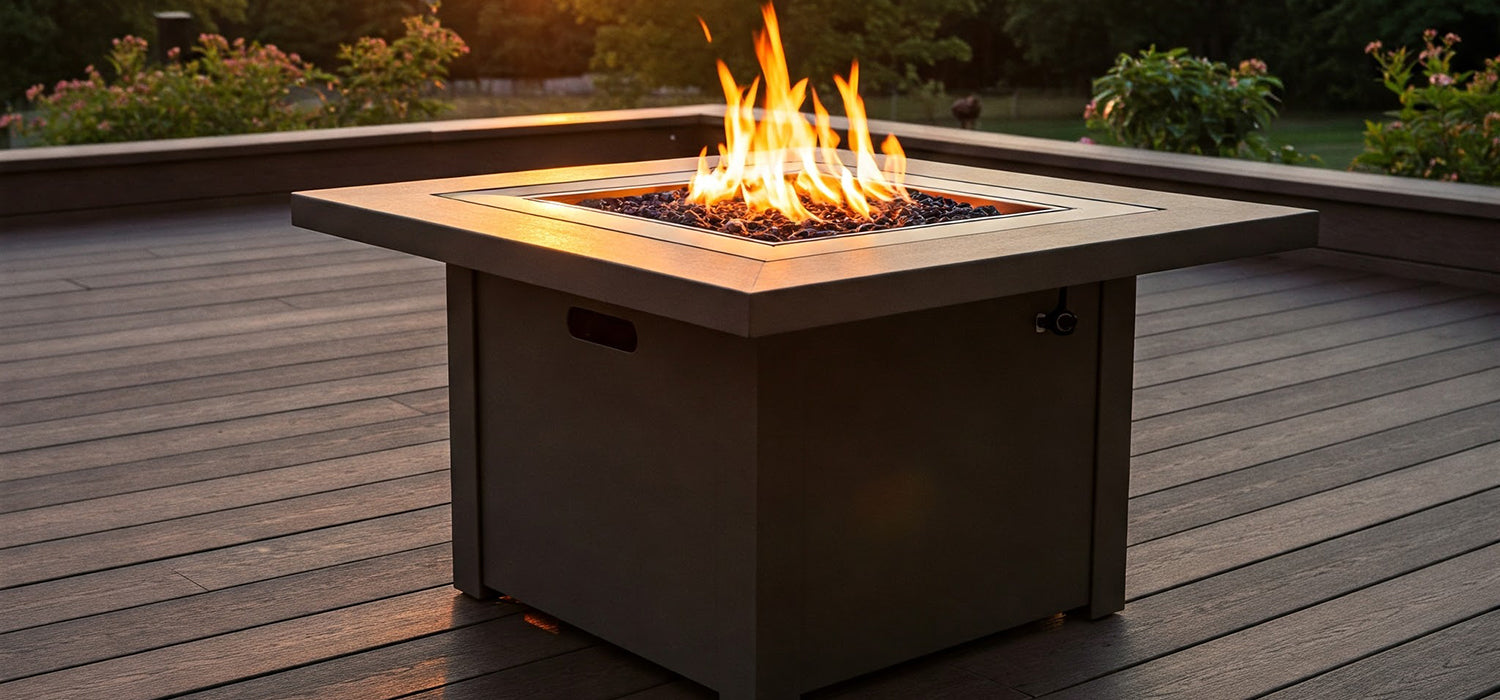
Why Does My Gas Fire Pit Whistle? Troubleshooting and Fixes
Is your gas fire pit—or fire table—sounding more like a teapot than a cosy backyard retreat? That high-pitched whistle is usually a sign of gas flow issues, but don’t worry! Keep reading to learn simple fixes and how to make your fire pit peaceful again, no plumber required.
Common Causes of Whistling Sounds
A whistling noise coming from your gas fire pit can be annoying and downright disruptive to a perfect evening. It’s more than just a nuisance, though—it’s usually an indication that something needs fixing. But what exactly is causing the noise?
Let’s break down the common culprits and their causes.
Gas Pressure Issues:
Gas pressure is one of the most common reasons behind that high-pitched whistle you hear. If your fire pit's gas pressure is too high, it can lead to vibrations in the system, producing an unpleasant sound.
High Gas Pressure Causing Vibration
Think of it this way: when the gas rushes through too quickly, it can cause vibrations, much like when you blow across the top of a bottle. This vibration travels through the system, creating that whistling noise.
Regulator Problems
Your fire pit’s regulator controls the pressure of the gas coming through. If it’s set too high or has gone faulty, it can cause the gas to flow too quickly, triggering the whistling sound. A worn-out regulator may be the problem, especially if it’s been in use for a long time.
Burner Port Blockages:
Another potential culprit is a blockage in your burner ports. These tiny holes where the gas flows can become clogged over time, making the gas flow uneven.
Debris or Dirt Clogging Burner Ports
Tiny debris, dust, or even spider webs can block the burner ports, causing the gas to struggle as it tries to flow through. Even small blockages can lead to a noticeable increase in noise.
Uneven Gas Flow
When the gas can’t flow evenly through the burner, parts of the fire pit may vibrate as the system struggles to keep up. This uneven flow often results in a loud whistling or humming sound.
Gas Line Restrictions:
If your gas line isn’t in tip-top shape, it could be causing the whistling problem as well. From kinks to improper sizing, gas lines can create restrictions that affect how smoothly gas flows through the system.
Kinked or Damaged Gas Lines
A kinked or damaged gas line can easily cause restrictions, similar to trying to drink through a straw that’s bent in half. If the gas can’t move freely, it leads to an unwanted build-up of pressure, which can result in the whistling sound.
Improperly Sized Gas Lines
If the gas line isn’t the right size for your fire pit, it can cause restricted flow. A gas line that’s too small for the system won’t deliver gas efficiently, leading to pressure issues and, yes, whistling.
Troubleshooting and Repair Steps
Now that we know the common causes, let’s dive into the troubleshooting steps to help you fix the issue. Thankfully, most of these solutions are simple and can be done on your own.
Adjusting Gas Pressure:
Adjusting the Regulator (If Applicable)
First things first—check your gas regulator. If you're using propane, it might be set too high. You can adjust it or replace it if it’s faulty. A quick adjustment could eliminate the whistling, leaving you with a peaceful flame.
Checking Gas Supply Pressure
For those with natural gas fire pits, the issue might lie with the pressure coming from your utility provider. If you're unsure about your gas pressure, it’s worth contacting your supplier or a technician to check the flow and adjust it if needed.
Cleaning Burner Ports:
Cleaning Clogged Ports with a Brush
If your burner ports are clogged with dirt or debris, they could be disrupting the gas flow. The solution? A good clean-up. Turn off the gas and allow the pit to cool down completely. Then, using a soft brush or a vacuum, gently remove any dirt or blockages from the burner ports.
Ensuring Even Gas Flow
Once you’ve cleaned the ports, it’s important to check that the gas is flowing evenly. Any remaining blockages could still be affecting the burner’s performance, so be thorough in your cleaning to avoid future issues.
Inspecting Gas Lines:
Checking for Kinks or Damage
Your next step is to check the gas line for any kinks, twists, or damage. If the line is damaged or kinked, it could be restricting the gas flow, which is causing the noise. If you find any damage, replace the hose immediately to prevent further problems.
Ensuring Proper Gas Line Sizing
Another important check is ensuring the gas line is the correct size for your fire pit. If it’s too small, it won’t provide enough gas for the system to work properly. A professional can help if you’re unsure whether your line is the right size.
Safety Precautions and Professional Help
While DIY repairs are often possible, safety should always come first. Here’s how to stay safe and know when it’s time to bring in a professional.
Gas Leak Detection and Prevention:
Using a Soap Solution and Smelling for Gas
Before you start tinkering with any of the components, it’s vital to check for gas leaks. You can use a simple solution of dish soap and water to cover the gas connections. If bubbles form, you’ve found a leak. Additionally, always give your fire pit a quick sniff—if you smell gas, turn off the supply immediately.
When to Hire a Professional:
Complex Gas Line or Regulator Issues
If you've checked the gas pressure, cleaned the burner, and ensured the gas line is in good shape, but the whistling persists, it might be time to call in a professional. A qualified technician can inspect the regulator, gas line, or any internal components that might be causing the issue, especially if the problem is more complex than it seems.
Conclusion
A whistling gas fire pit can be a frustrating issue, but it’s usually a simple fix once you know what to look for. Whether it’s adjusting the gas pressure, cleaning the burner ports, or fixing a damaged gas line, there are plenty of DIY fixes that can bring your fire pit back to its peaceful state. However, if you’re still hearing the whistle after all that, don’t hesitate to call in a professional. Your backyard retreat deserves to be free of noise—except, of course, for the sound of crackling flames!
Other content we think you'll love
- How to Light a Gas Fire Pit: The Complete Guide to Safe and Easy Lighting
- How to Fix a Fire Table That Won’t Stay Lit
- How to Fix a Gas Fire Pit: Troubleshooting and Repairs Made Easy
- How to Light a Gas Fire Pit with a Lighter: A Step-by-Step Guide
- Why Does My Gas Fire Pit Keep Going Out?
- How to Repair a Gas Fire Pit: A Step-by-Step Guide
- How to Repair Your Outdoor Gas Fire Pit: A Homeowner’s Guide to Fixing Common Problems
- Why Does My Gas Fire Pit Sound Like Wind? Here’s What’s Going On
- How to Turn On Your Gas Fire Pit: A Step-by-Step Guide
- How to Safely Put Out Your Fire Pit (Without Stressing or Guessing)
- Why Is My Gas Fire Pit Not Lighting? Here’s How to Fix It Fast

